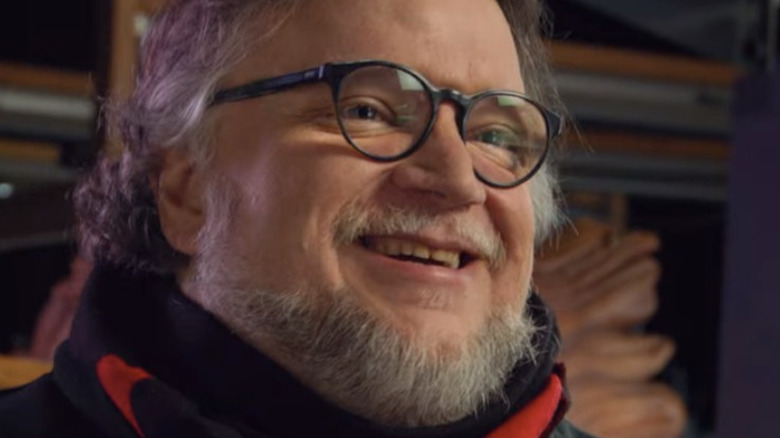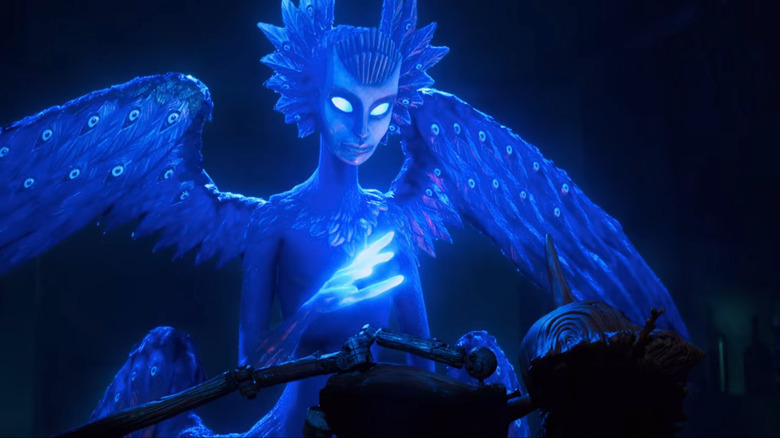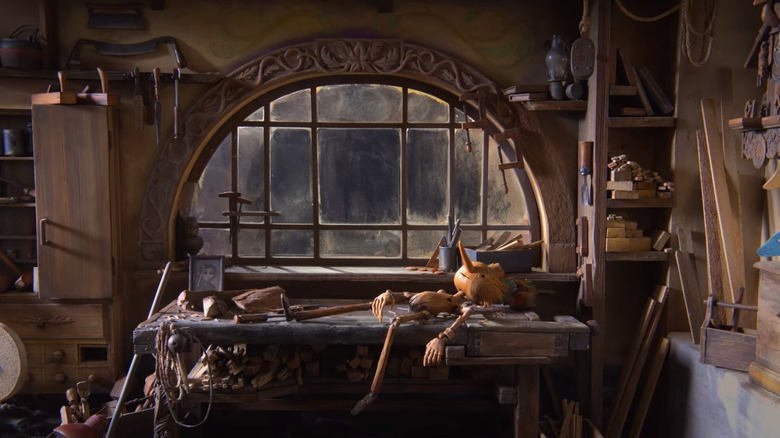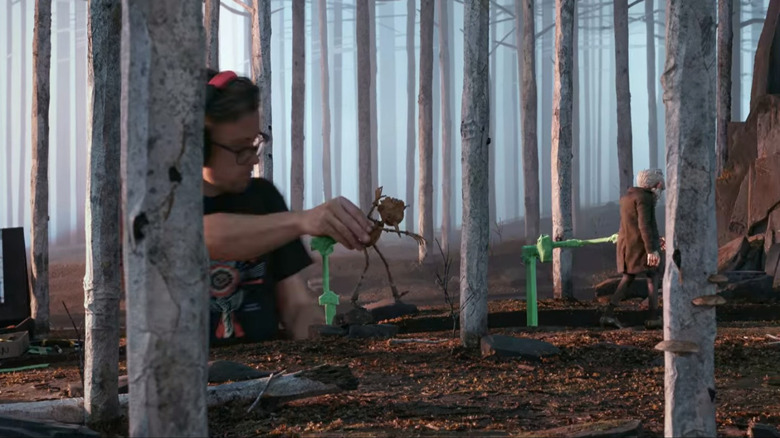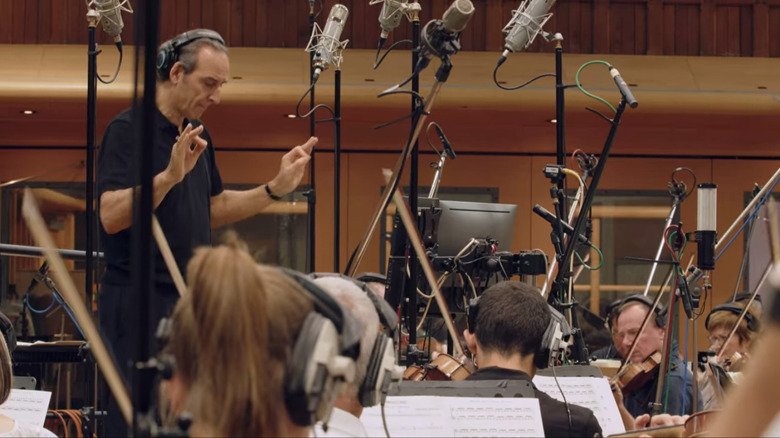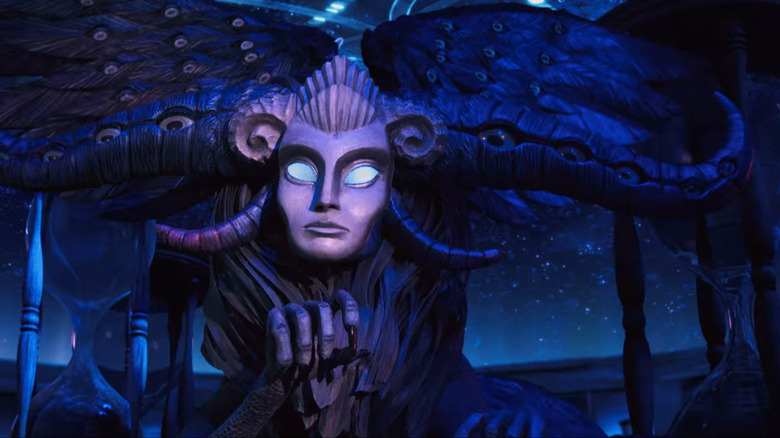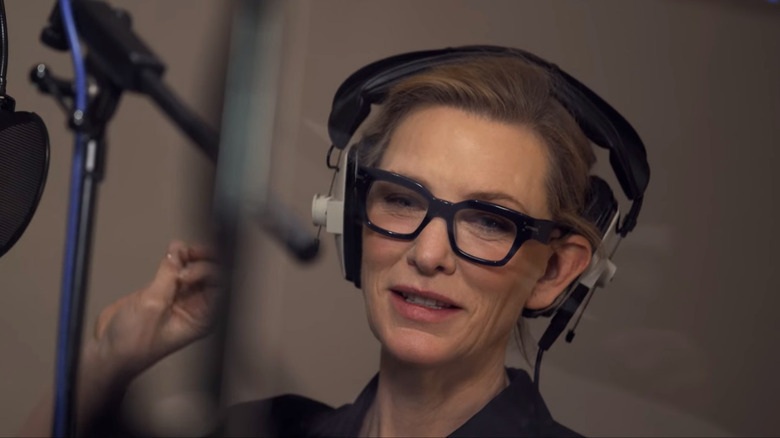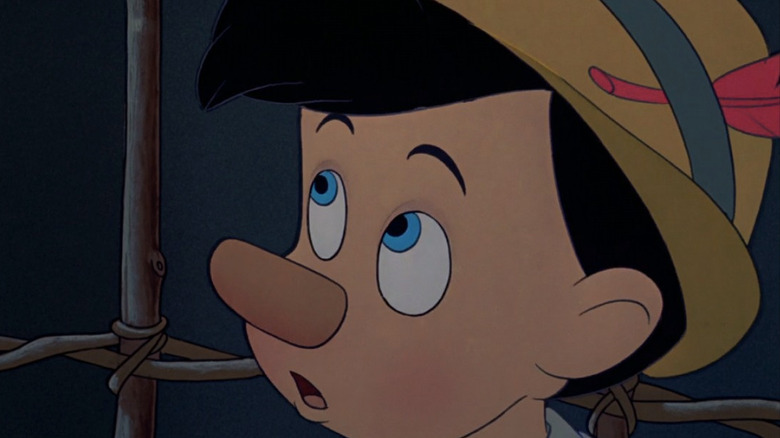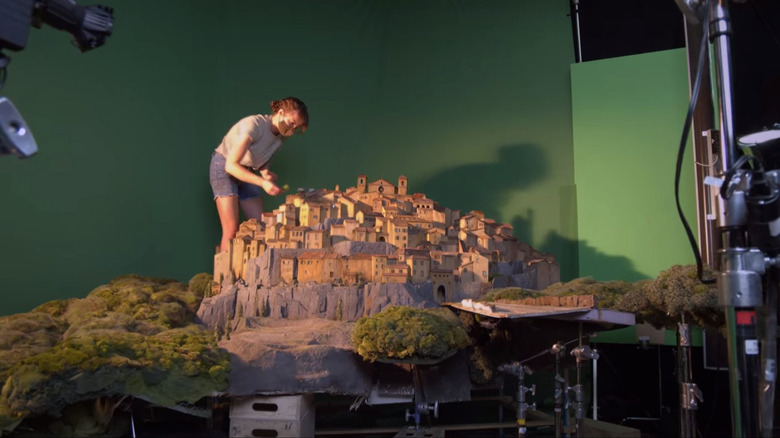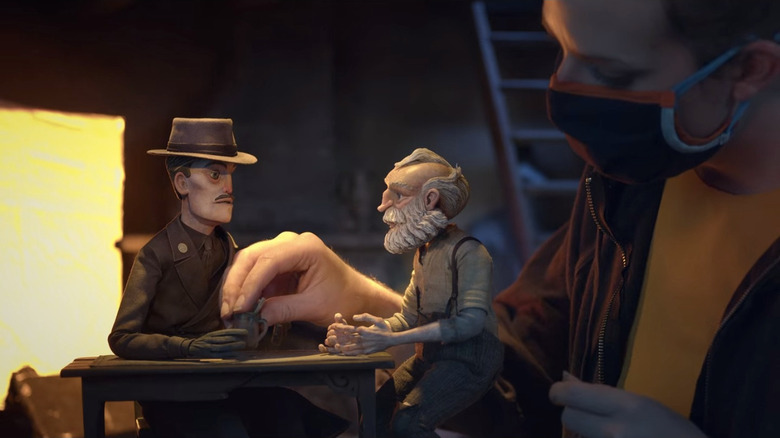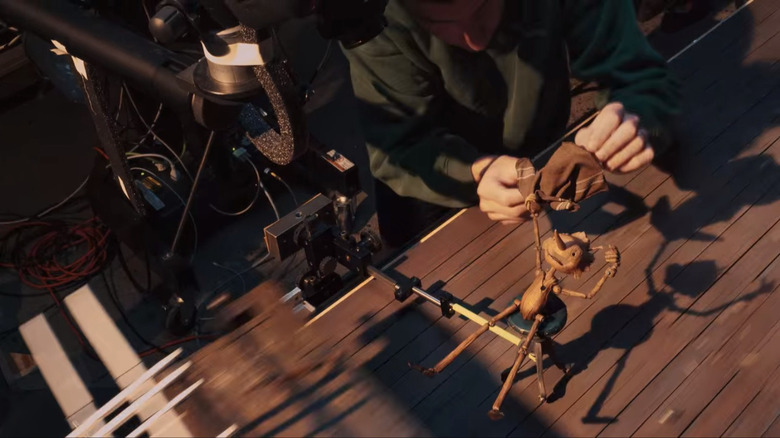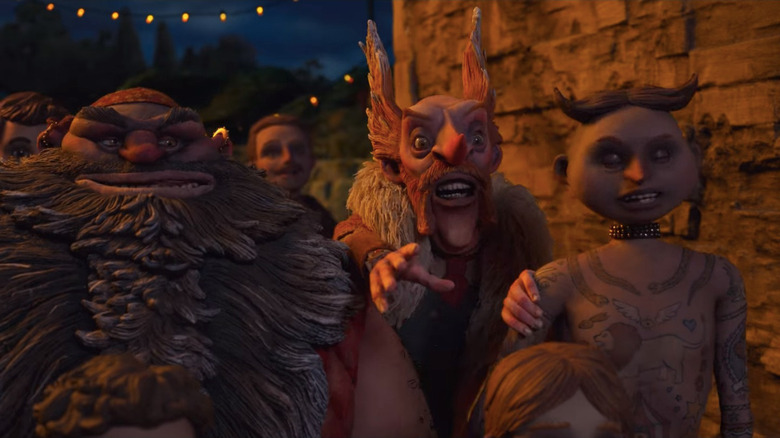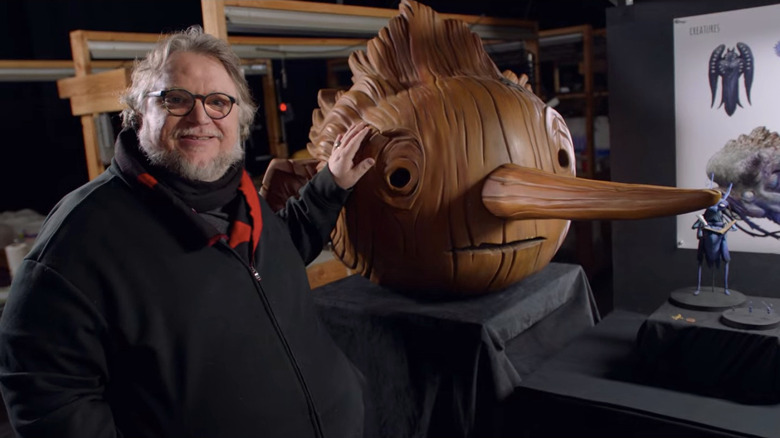How Guillermo Del Toro Made Pinocchio A Tale Worth Revisiting
"Pinocchio?" Been there, done that — and then some. Hollywood has told, retold, and then told again every classic fairytale so many times that it's hard to imagine a new take on a familiar story being worth revisiting at all, much less adding something new to our understanding of the original. Filmmakers have so frequently proclaimed, "You may think you know this story, but you actually don't know it all," that this promise seems like noise in the crowd, another entry in a catalog alongside the likes of everything from "Snow White and the Huntsman" to "Maleficent" to "Once Upon a Time."
Yet, when director Guillermo del Toro utters practically the same promise for his stop-motion remake of "Pinocchio," one may be inclined to believe him. Upon viewing the 2022 film, the audience discovers del Toro and fellow director Mark Gustafson have struck lightning in a bottle to create a brilliant film. In its first weekend on Netflix, "Guillermo del Toro's Pinocchio" was the streamer's top movie worldwide and, days later, was nominated for Golden Globes for best animated picture, best score, and best song (for "Ciao Papa").
However, lightning in a bottle (that is to say, unlikely luck) has very little to do with the success of "Pinocchio." Its endearment is instead a product of del Toro and his team's commitment to the detail of its visuals and the thoughtfulness of its story across, astoundingly, over a decade of development and production.
To Guillermo del Toro animation is an art form, not a genre
Animation is often incorrectly labeled. When introducing the Oscar for best animated film in 2015, Dwayne Johnson called animation "Hollywood's most successful and innovative genre." While well-meaning, this remark implies that all animated films tell their stories within the same category. It's like saying all live-action films are the same genre. They're not. There are comedies, fantasies, dramas, adventures, and so on. At the 2022 Oscars, presenters Lily James, Halle Bailey, and Naomi Scott, when similarly introducing the award for best animated feature, insinuated that animated films are made primarily for children — even though one of the nominees that year, "Flee," was rated PG-13 and not intended for kids. While in both of these cases the presenters were simply sticking to a script, their comments hint at a stigma about animation — one that Guillermo del Toro seeks to debunk.
In the documentary "Guillermo del Toro's Pinocchio: Handcarved Cinema," which debuted on Netflix alongside the film, del Toro acknowledges consumers' perception of animation as a genre. He insists, though, that it should be thought of as an art form — and that even within that art form, there are many avenues an artist can take, whether that be hand-drawn, computer-generated, or, in the case of "Pinocchio," stop-motion. "Of all the art forms of animation," del Toro says, "to me the most sacred and magical is stop-motion because it's the bond between an animator and a puppet."
Del Toro has a lifelong personal connection to Pinocchio
For Guillermo del Toro, making "Pinocchio" wasn't just another project to add to his filmography. It was something he dreamed of creating since childhood. Growing up, del Toro's mother gave him a wooden Pinocchio as a gift every few years, the director told Jimmy Fallon. While del Toro's mom, unfortunately, passed away just before the film premiered, she had long known that it was a movie her son wanted to make.
In finally directing the film, which had been incubating for decades, del Toro imbued his "Pinocchio" with a strong sense of family, as the titular character represents a familial connection for him. In "Handcarved Cinema," del Toro says the movie "has a huge heart. It deals with who you are, staying true to yourself, and not having to change to be accepted. It also is about being a father and being a son, learning to love your family for who they are and how they are."
Del Toro subverted key themes of Pinocchio's story
Many recognizable elements of Carlo Collodi's original "Pinocchio" story — and many qualities that were also expressed by various filmmakers in the excess of "Pinocchio" adaptations over the years — remain in Guillermo del Toro's version. However, there are a few key points that del Toro doesn't just tweak but completely subverts. As the audience anticipates one thing, the director turns that expectation on its head in a way that pulls new meaning from familiar story elements.
In an interview with the American Film Institute, del Toro explains, "We turned the whole story upside-down. It was not about obedience being a virtue, but disobedience being a virtue. Instead of everybody changing Pinocchio, he changes everybody." When thinking these comments through, del Toro's reasoning is fresh and brilliant. To be a hero in this telling of the story, Pinocchio (voiced by Gregory Mann) has to stray from the norm rather than adhere to it.
Furthermore, nearly every other version of the story focuses on Pinocchio's goal of becoming a real boy. Here, though, this is not a primary concern. While visiting "The Tonight Show," del Toro said, "The one that learns the lesson in this 'Pinocchio' is this guy," pointing to the Geppetto puppet he brought with him. "Geppetto learns to be a real father, as opposed to Pinocchio learning to be a real boy."
Pinocchio's composer only used wooden instruments
In a film with as much intentionality as "Pinocchio," the story and characters seep into all aspects of the production in a way that lesser-detailed films don't think of. For instance, in composing the score, Alexandre Desplat could have simply written the music to match the scenes. But does anything about "Pinocchio" lend itself to leveraging music in a unique way that not only complements the action onscreen but speaks its same message in and of itself?
Desplat, who won an Oscar for scoring del Toro's "The Shape of Water," had a marvelous idea to only use wood instruments for the music in "Pinocchio," as he shares in the documentary "Handcarved Cinema." Desplat notes, "We have the guitars, the mandolin, the piano, the harp, and all the woodwinds, the bassoons, the clarinets, the oboes, the flutes. All these instruments are in wood, which creates a very strange environment that belongs to Pinocchio."
A Mexican poem inspired the story
"Guillermo del Toro's Pinocchio" is profound, mature, and multi-layered. With its story resonating on such a deep level — feeling inherently different from other "Pinocchio" retellings while somehow retaining the heart of what the story has always been — one might wonder if its director looked to any particular source of inspiration as his jumping-off point.
In an interview with the Los Angeles Times, del Toro references a poem by Jaime Sabines, which reads: "All my life, I've heard a voice whispering softly in my ear, 'Live, live, live.' It was death." In creating a film about a father processing death and an inanimate object gaining life (with a release date that happened to coincide with the death of del Toro's mother), the director presents the viewer with an exploration of the symbiosis between these states of being. While opposites, life and death provide one another with purpose, and the beauty of that dichotomy is the heartbeat of "Pinocchio."
Cate Blanchett pleaded for del Toro to cast her
Upon seeing Cate Blanchett's name listed in the credits for "Pinocchio," the audience might have to pause and wonder where they heard Blanchett's voice in the film. She portrays none other than Spazzatura, the monkey accomplice of Count Volpe at the traveling show. Spazzatura only communicates in monkey sounds, making it difficult to place Blanchett as his voice actor and astonishing to imagine her performing his role.
Blanchett was determined to be part of "Pinocchio," no matter what it took. Blanchett's casting, which in "Handcarved Cinema" Guillermo del Toro calls "a blessing and an accident," originated on the set of "Nightmare Alley," the 2021 film directed by del Toro and starring Blanchett as Dr. Lilith Ritter. Del Toro remembers, "Cate Blanchett and I were having such a good time that she said, 'You gotta give me a part in 'Pinocchio.' I go, 'The only other part left is a monkey.'"
Upon seeing the designs for Spazzatura, del Toro recalls that Blanchett remarked, "I think this is my spirit animal." Blanchett affirms her enthusiastic sentiments for participating, saying she "would do anything" to be part of the film. She was thrilled to join the cast, drawing inspiration from del Toro's laugh in her performance as the chaotic monkey.
Del Toro adapted a central aspect of Disney's version
Guillermo del Toro grew up with Walt Disney's 1940 animated version of "Pinocchio," known for its Oscar-winning song "When You Wish Upon a Star," which became something of a theme for the company. Disney's "Pinocchio" exudes the signature style of what is now referred to as the golden age of Walt Disney Animation Studios. As only the second full-length Disney film ever (following 1937's "Snow White and the Seven Dwarfs") "Pinocchio" embodies qualities that were indicative of the fledgling studio in 1940, with its pristine hand-drawn animation and likable, engaging characters.
Deviating from the Disney norm, however, is the way "Pinocchio" leans into something del Toro admired when adapting his version of the tale. Speaking with Jimmy Fallon, del Toro mentioned, "Disney understood one thing: that in order to appreciate the light, you need a darkness." The number of villains in Disney's "Pinocchio" is nearly the same count as the good guys. A thief aggressively kidnaps a distraught Pinocchio. A boy terrifyingly transforms into a donkey before the audience's eyes. Given the cheery reputation Disney upholds, "Pinocchio" is decidedly dark. In assessing del Toro's style of filmmaking and now knowing the high esteem in which he holds Disney's "Pinocchio," it's easy to see the film's influence on his work and how it informed his unique approach to adapting the story.
Artists built the sets with layers of storytelling
There's a lot to take in when viewing "Pinocchio," and it's easy to get swept up in the story. While the narrative is engaging in its own right, audience members who consciously pay attention to the sets will notice even more storytelling to be found. Guillermo del Toro wanted the sets to show they had served many purposes in the story before their current function. If viewers look closely, they can appreciate these details that contribute to the aesthetic and backstory of Pinocchio's village.
As del Toro explains in the "Handcarved Cinema" documentary, the crew did "a huge amount of research" to determine what the condition of these buildings would have been in their 1930s state. "All the structures in the town had the remnants of their origins, like medieval ruins," del Toro says, "and on top of that, you have 18th-century carvings, and then you have murals that were frescoes from the 1500s, 1400s. It feels layered." Sharp-eyed viewers get nearly as much story from the set as they do from the dialogue, with every detail informing the character of the town and its history.
The animators embraced imperfections
When an audience watches a movie, they know that what's on the screen is fake. A scriptwriter wrote the scene, a director brought their vision of the scene to life, and actors performed it. The whole thing is fabricated. There are some tiny nuances, though, that add to the believability of a live-action movie. There are motions that the actors might not even realize they're doing — body language inherent to human behavior that isn't planned for as part of the scene. Those imperfections sell the realism of the creation perhaps more than anything else.
In animation, where artists meticulously craft every detail, these moments don't just happen by themselves. They have to be strategized. "You can make [the puppets] make mistakes. When you work with live actors, you expect to create something that feels alive, but with a stop-motion puppet, you have to animate mistakes," del Toro said on "The Tonight Show," adding that as viewers watch "Pinocchio," they'll see the puppets "do failed acts: stumbling, kicking a bottle that is laying around, sort of stumbling around. All of that is pre-planned to be animated like that."
The film took over 10 years to make
The nature of stop-motion animation means that production is slow going. With its artists carefully animating the characters and sets ever so slightly between capturing every photograph that makes up the film's visuals, stop-motion is not a passion for an impatient spirit. For "Pinocchio," the time from early development to premiere was much longer than the industry norm. From start to finish, it took Guillermo del Toro over a decade to bring "Pinocchio" to life.
This was partially because del Toro struggled to find a studio that would give his "Pinocchio" a chance, even after a lot of pre-production work was complete. Del Toro told Jane Pauley on "CBS Sunday Morning," "When you have the whole world designed, and you've storyboarded, and you have a great screenplay, and you know what it could be, and people keep saying 'no,' that's really hard." With a laugh, he continued, "Then it gets harder when they say 'yes' because now you have to deliver the whole thing."
Though the process took longer than he may have predicted, del Toro prefers a longer work time that creates a great movie rather than rushing something that isn't good. He remarked, "Either you make the movie the right way, or it's almost as good not to make it." Helping to speed up the process once the movie was officially greenlit was an astounding 60 stages on which animators simultaneously created the various scenes of "Pinocchio."
One puppet went from main character to extra
Count Volpe (voiced by Christoph Waltz) recruits Pinocchio to perform in his traveling circus. Some form of Volpe's character has existed in most tellings of the "Pinocchio" story. For example, he appears in Carlo Collodi's original story as Mangiafuoco and in the Disney version as Stromboli. In nearly all of these versions of "Pinocchio," the ringmaster is large and imposing. Guillermo del Toro shares in "Handcarved Cinema" that he "had a bad feeling" that this direction for the character was "very much a cliché."
With this in mind, designers created a new design for Volpe, which is what appears in the film. However, the original villain puppet was already fully built. Not wanting to waste the finished puppet, animators included the figure as an extra in the background of many of the circus scenes. The burly, bearded man in the crowd originally had a much more prominent role to play.
Animators used a giant Pinocchio puppet for some scenes
Sebastian J. Cricket (voiced by Ewan McGregor) accompanies Pinocchio and writes prolifically about his journeys. Since Sebastian is a cricket, close-up shots of him required animators and puppet designers to get creative with their scale, as the behind-the-scenes Netflix documentary shows. In such cases, Sebastian was a full-size puppet just as tall as other characters' puppets from other scenes but still appearing small thanks to oversized sets and objects around him in the frame. Sebastian often interacts directly with Pinocchio, standing on his shoulder or even inhabiting the hollow space inside Pinocchio's chest. For these scenes, animators built a huge version of Pinocchio, much larger than the puppet used for most of the movie, to accommodate Sebastian's size.
Also relating to Pinocchio's structure, viewers may notice that Pinocchio himself is asymmetrical. The sides of his face are not uniform. It almost seems as if two different people constructed him. Guillermo del Toro explains this is intentional since Geppetto (voiced by David Bradley) carves Pinocchio while intoxicated. The woodcarver begins the job with his typically perfect work ethic, but quickly becomes impatient and completes the rest of the puppet quickly and sloppily.
